|
Air
Force Museum America's
Packard Museum Auburn Cord
Duesenberg Museum Buick Museum
Chrysler
Museum John
Deere Tractor and Engine Museum Gilmore Car Museum
Kansas Aviation
Museum Kokomo Auto Museum
Michigan
Firehouse Museum
Missouri Museum of Military
History Museum of
Flight National
Automobile and Truck Museum
National Packard Museum
North Carolina Maritime Museum
Rolls-Royce Heritage Trust
Allison Branch
RE Olds Transportation
Museum Ropkey
Armor Museum Studebaker Museum
USS Alabama Aviation Museum
War in the Pacific Museum
Wright Museum of WWII
Ypsilanti Automotive Heritage Museum
R.E. Olds Transportation Museum - Lansing, MI
The Museum that is named after
Ransom E Olds is more than about just the cars and trucks that bore his
name for over 100 year after creating what became the Oldsmobile Division
of GM and the Reo Motor Car Company. (Reo can be written as Reo or
REO. It is pronounced as one word and rhymes with Leo.) Contained in the museum is
the early industrial history of Lansing when the city had multiple car and
truck manufacturers. To one like me that was raised within a mile of
both the Olds and the Reo it lets me understand my roots in the auto
industry.
Significant for the history of
Lansing but also Delco Remy is that the oldest DR parts located up until
this time by me are at
this museum.
Note: There are
102 photos in this section.

This is a 1938 REO Speedwagon. Reo is
all one word and not R-E-O as in the 1967 rock band. Now you know
where they got the name for their band.
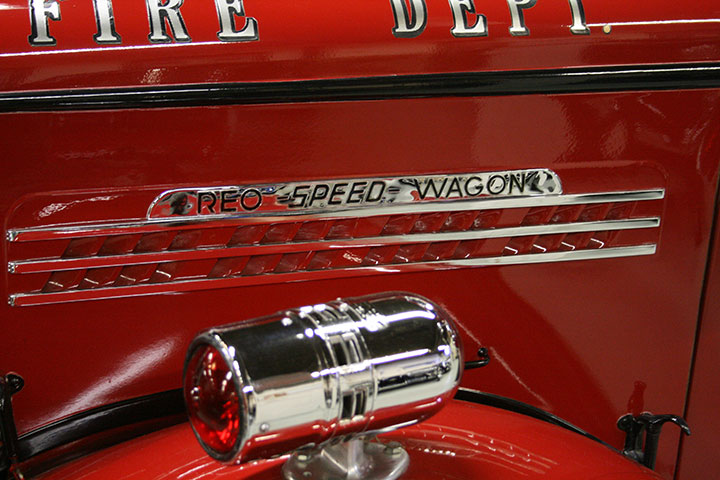
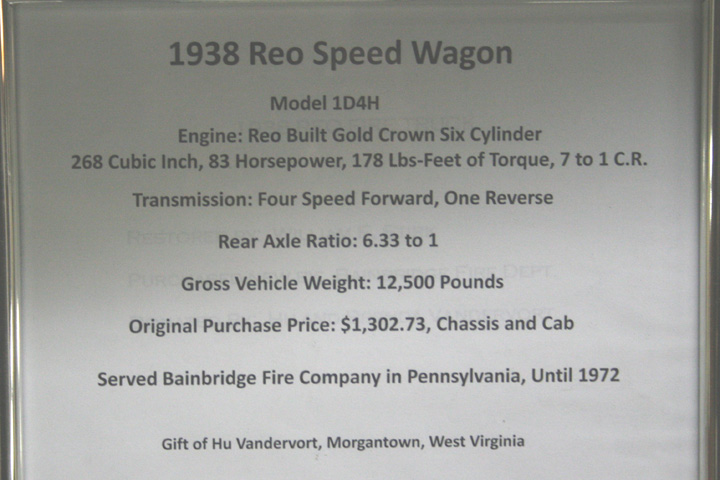
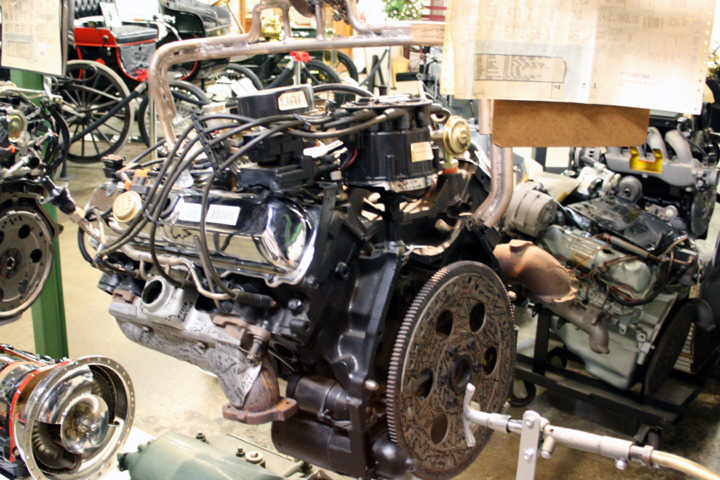
The first engine one sees when he walks into
the museum is this V-8, which has the distinction of being the last engine
built by the GM division BOC, or Buick-Pontiac-Olds on April 5th, 1990.
Of course it has Delco-Remy components.
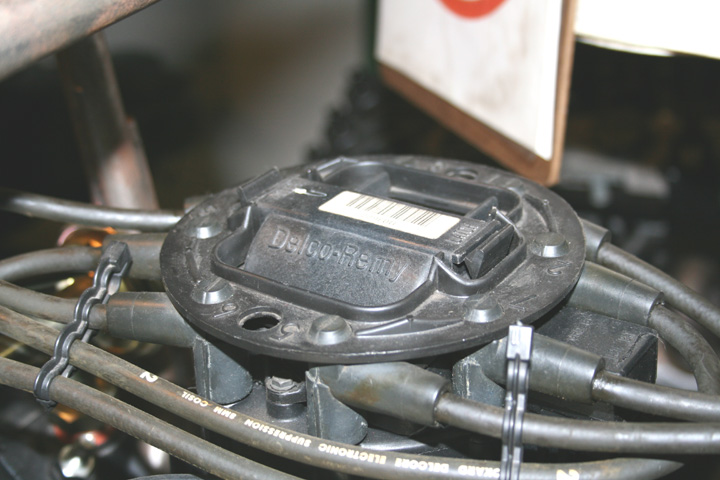
A Remy HEI is right on top. Model
1103677.

Because this was the last V-8 produced by BOC
in Lansing all of the workers signed the engine. One of them signed
the HEI for posterity.
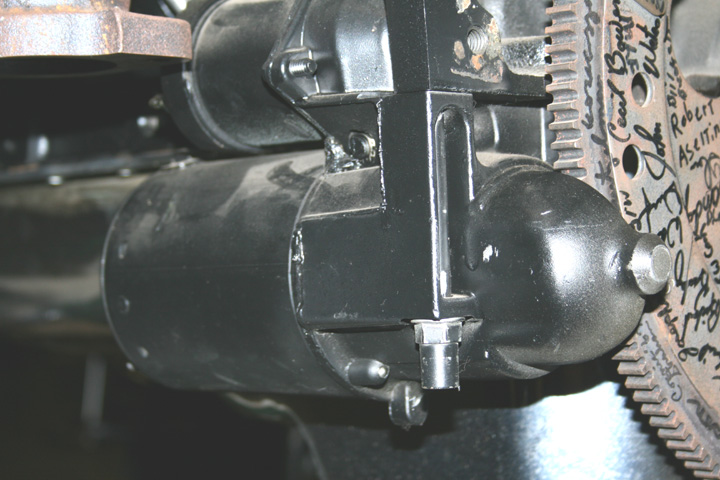
Right next to the DR starter and solenoid is
the flywheel with many signatures visible.
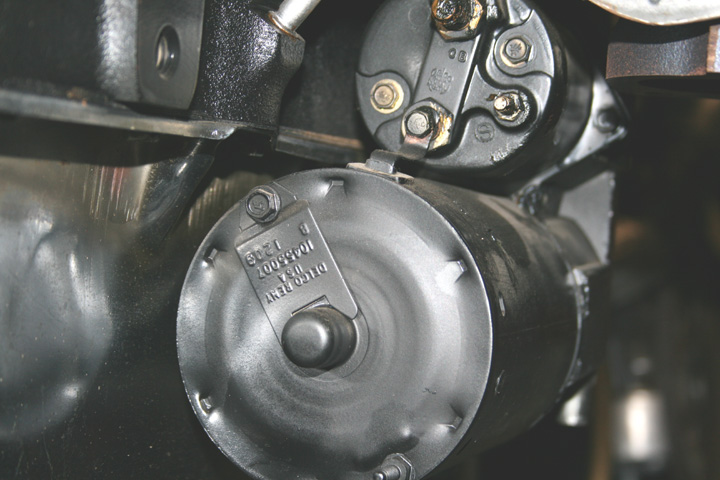
The motor with the Delco-Remy ID tag and the
solenoid with the Delco-Remy name on the cap.

Also on the engine was this DR air solenoid.
Note the signatures on the oil fill pipe.
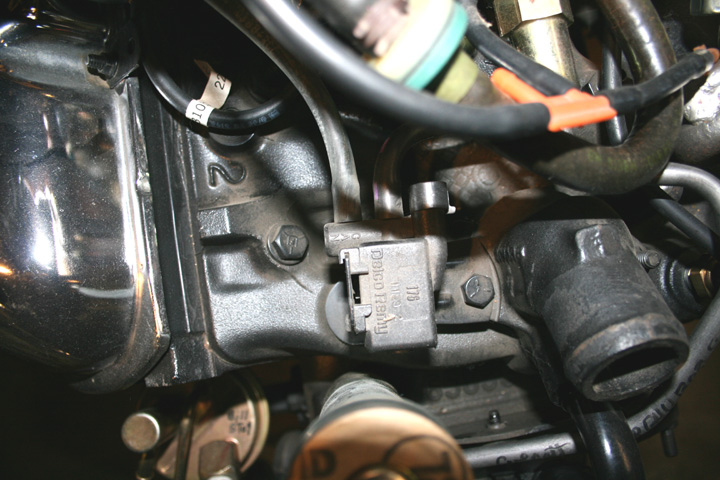

Reo built mowers, some without engines, and
snow blowers.

Wheel Horse was sold to Toro and Motor Wheel
was sold to Goodyear. Wheel Horse stated in a garage in South Bend,
IN.
Reo Engines:
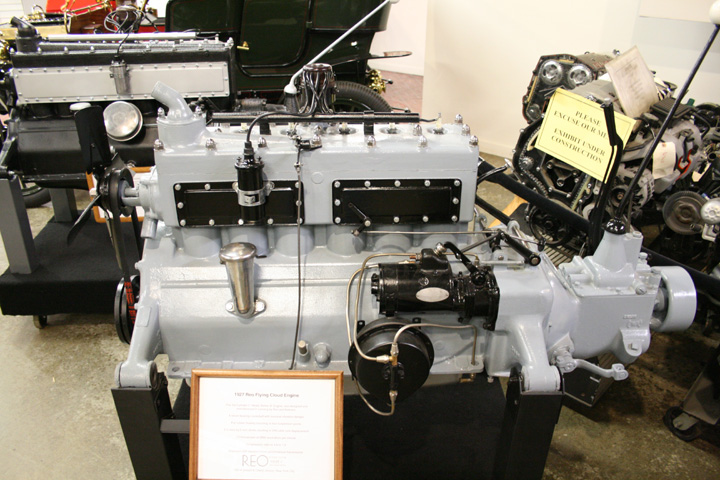
Next engine in the museum is a 1927 REO Flying
Cloud engine with some really interesting Remy parts on it. From
this view one can see the starter, ignition coil, and distributor.
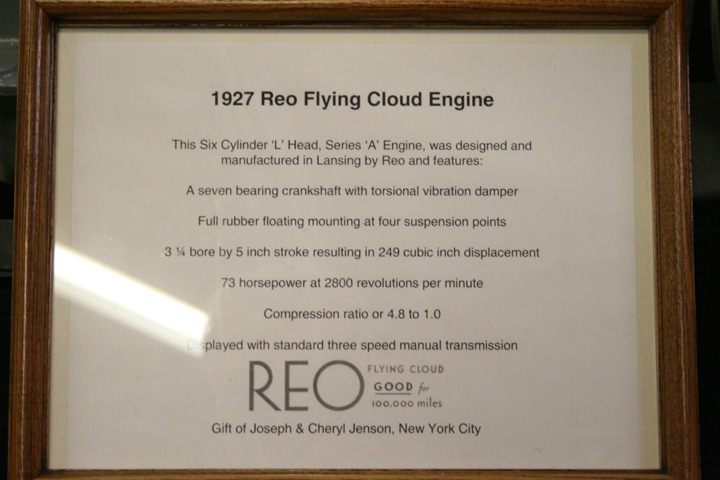
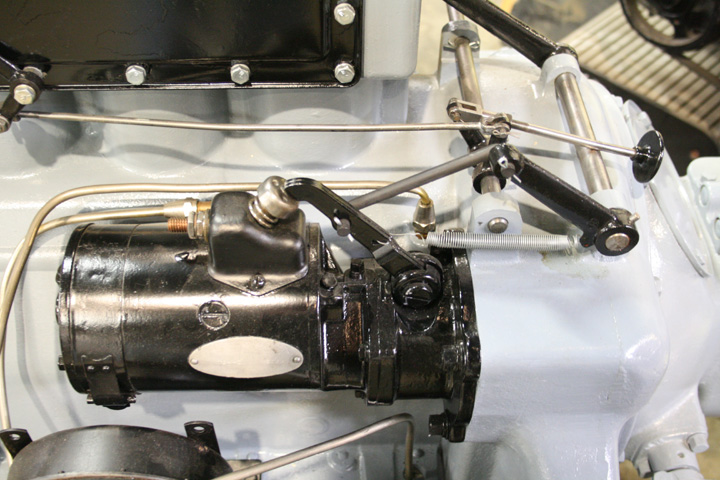
This Delco-Remy starter is starts cranking
when the driver presses down on the lever assembly to the right of the
motor with his foot on the floor of the vehicle.
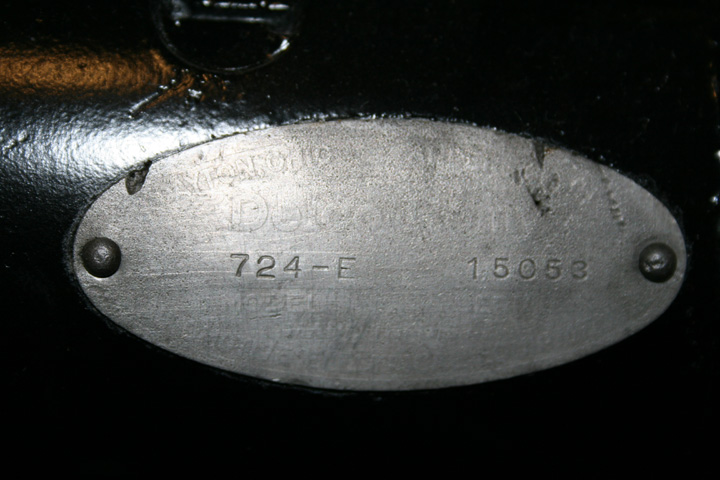
This tag on the motor is well worn but one can
determine that it is Model 724-E, Serial Number 15053 and the name Delco
Remy. Also note that the location is given as both Dayton, OH and
Anderson, IN. This was during the time of transition when Remy
became sole source of starters for GM and the Delco Dayton product line
was moved to Anderson. The 724-E Model Number is a Anderson Remy
number.

There is a Delco-Remy Coil on the Flying Cloud
Engine.
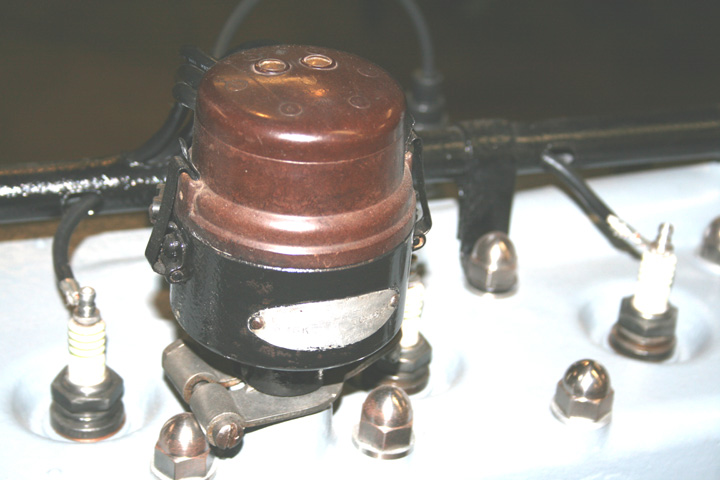
Model 636K Serial 10462 Delco-Remy
Distributor.

This ID tag is so worn on the distributor but it appears this may also
have both Dayton, OH and Anderson, IN on it.
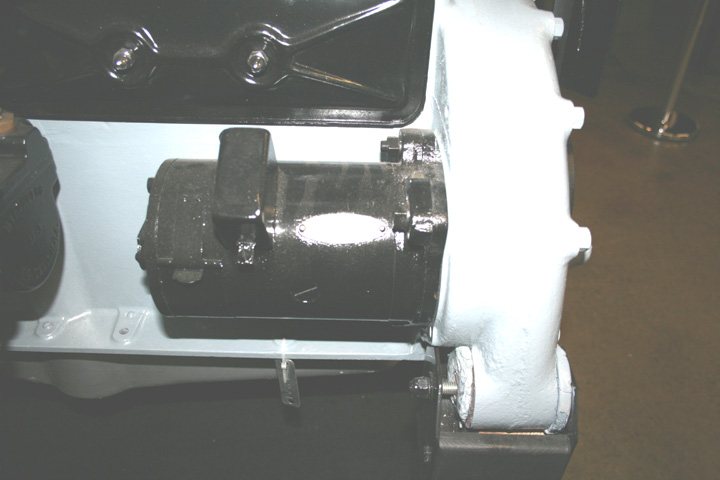
The DC generator.
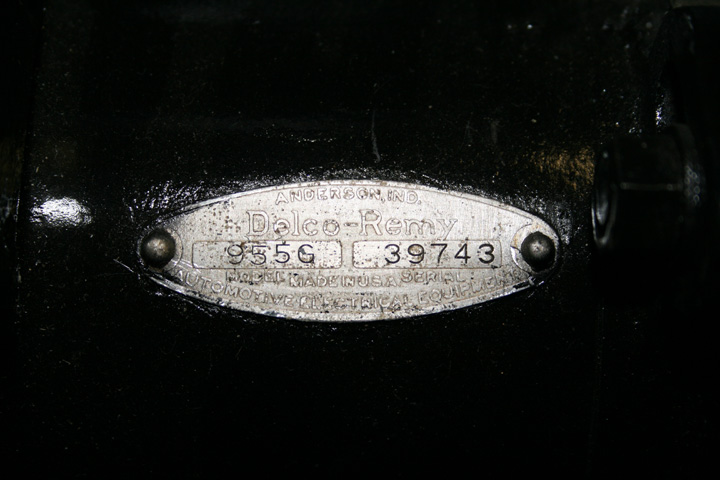
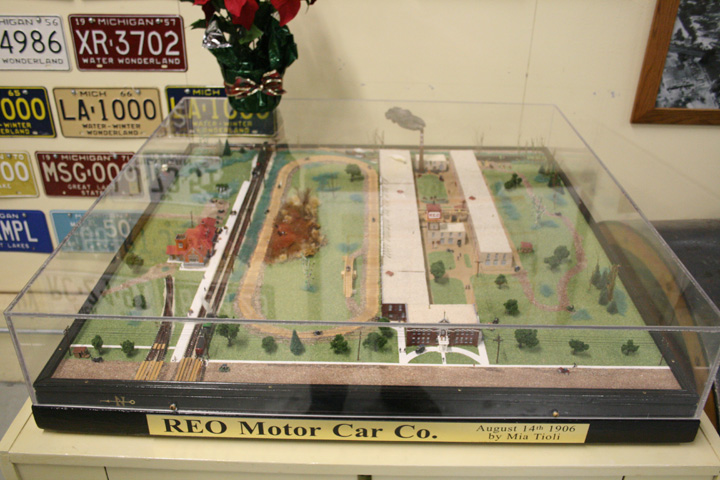
Mia Tioli made this excellent looking model of
what the Reo Plant looked liked in 1906. In the end most of the
green space was covered with factory expansions. The road along the
bottom is Washington Ave and I used to walk this section of Washington
from my house to the downtown area during the mid sixties which would be to the left or north . I remember trucks, and especially Army 2&1/2
ton and five ton trucks, coming off the assembly line no doubt on their
way to Vietnam. In the lower right hand corner which would be the
intersection of Baker Street and Washington the City of Lansing had a
firehouse with a Seagrave engine. On the site where the west side of
the test track is located the Reo Clubhouse was later built. My
grandfather worked at the Reo and was involved in the sit-down strike in
1937 that lasted four weeks and was one of the few strikes of the type
that was non-violent. My grandmother helped along with other wives
by providing food, blankets and other necessities to the workers inside.
After the strike my grandfather got a job at Fisher Body which was timely
as Reo went bankrupt in 1939 which closed the doors for a year. Because of his skill set the government
had my grandfather
transfer to the Nash-Kelvinator plant during WWII where he became
supervisor of the propeller balancing department for Hamilton-Standard
Propellers. By the end of the war the plant produced 158,134
propeller assemblies and 85,656 spare blades, second in production only to
the home plant of Hamilton Standard. After the war my grandfather
returned to Fisher Body.

Looking south with the Lansing railroad
station for the Grand Trunk Railroad. Now you know where Grand Funk
Railroad got its name from.
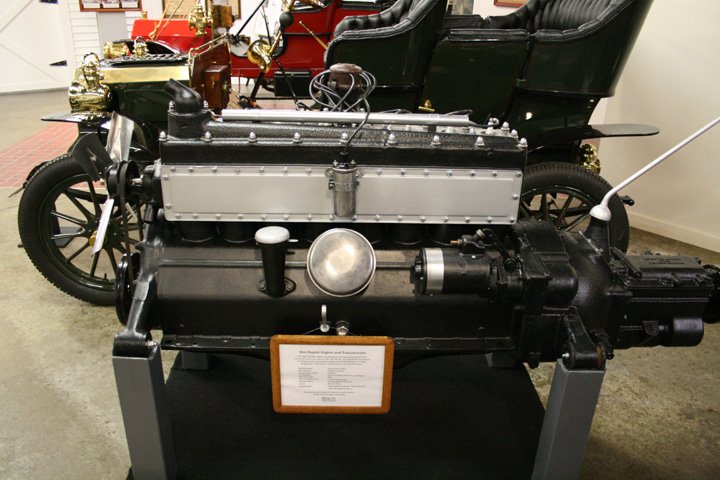
Right next to the six cylinder Flying Cloud
engine is the eight cylinder version know as the Royale. The
generator, starter and distributor all look identical (the distributor
having 8 output wires rather than 6) to the components on the previous
engine but have no DR tags. The coil is stainless steel but is marked DR.
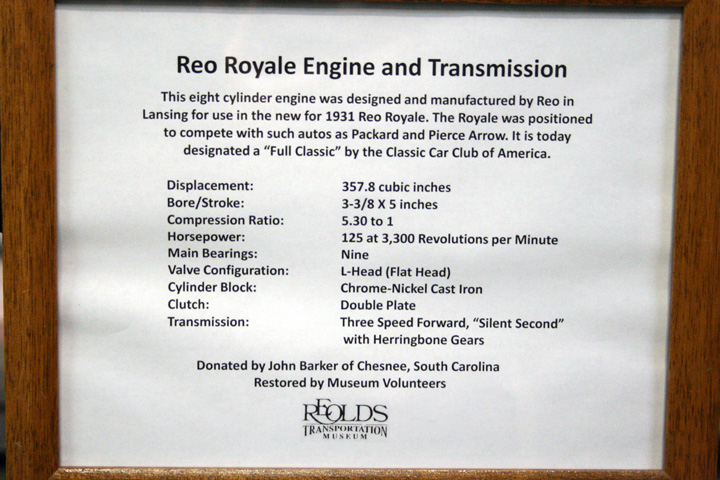

The ignition coil with a stainless can.
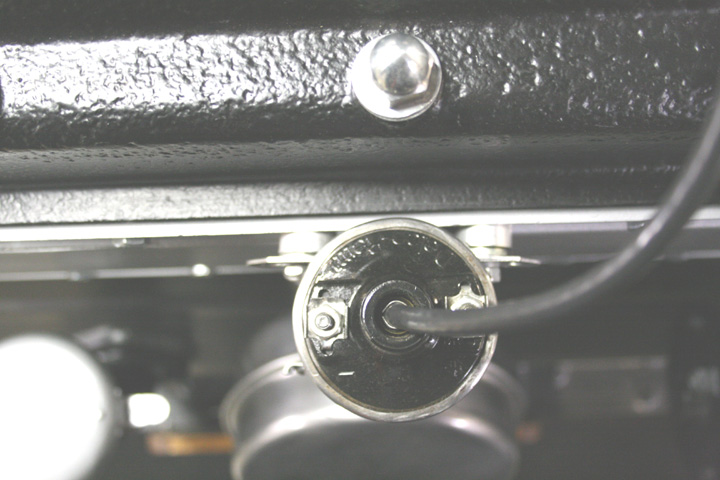
Delco-Remy can just barely be made out on the
top upside down.

The Distributor looks just like the one on
previous six cylinder Flying Cloud engine except for being for a straight
eight. There was no tag on it.

Starter with no ID Tag.
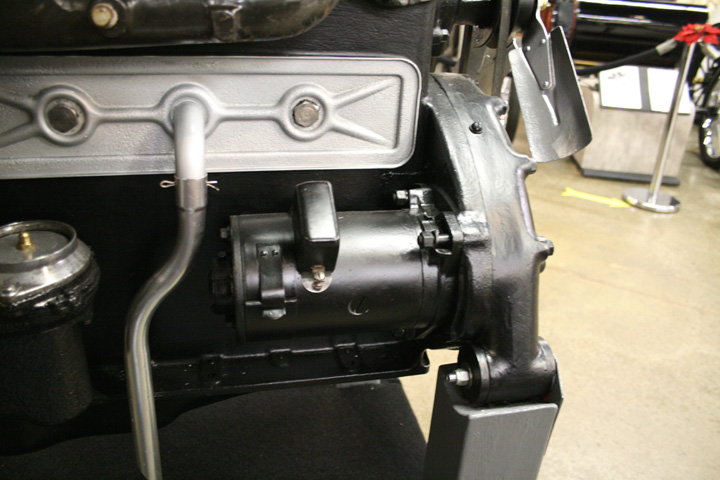
DC Generator with no ID Tag.
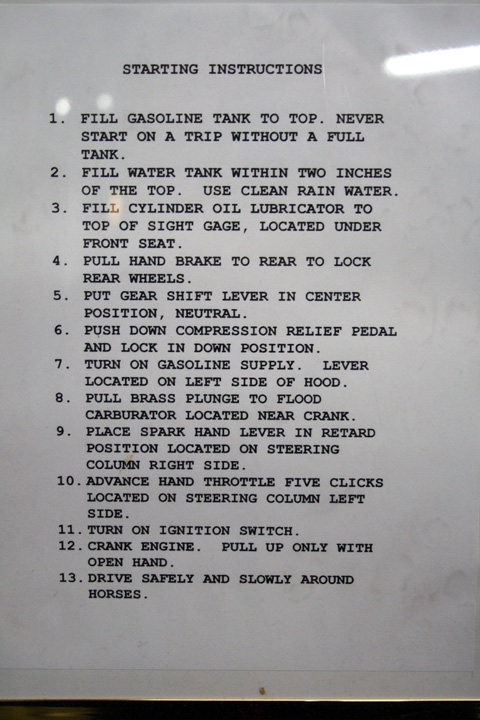
Starting instructions for a 1909 REO.
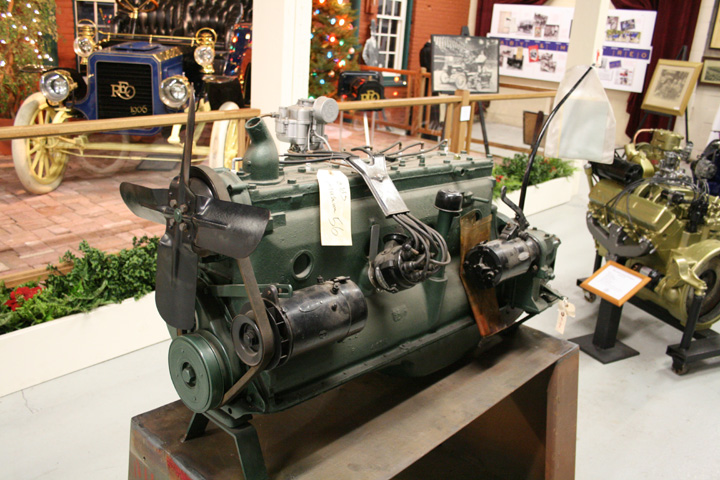
This unidentified REO engine has DR generator,
distributor and starter on the driver's side of the engine. There
was no coil mounted on the engine.
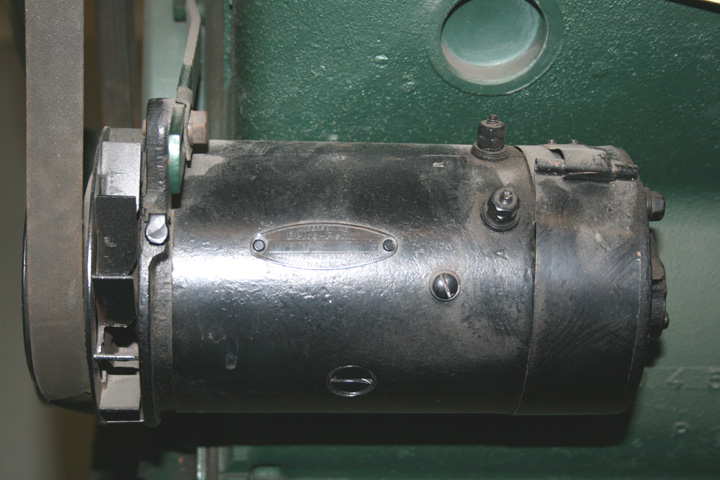
Delco-Remy DC generator 1102664 serial number
7B 5.
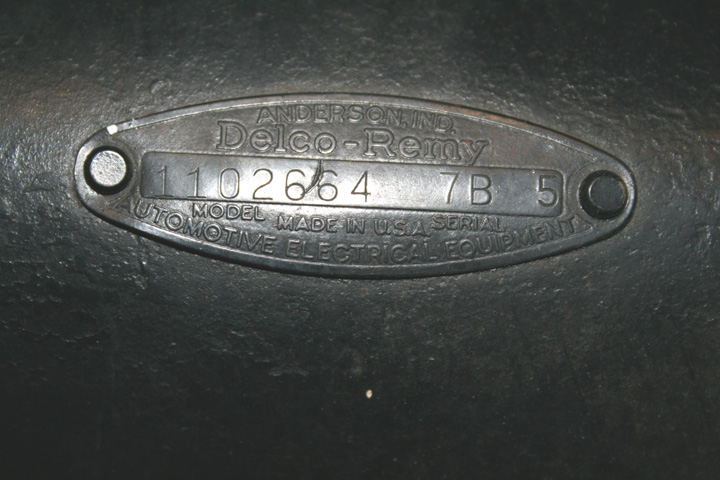
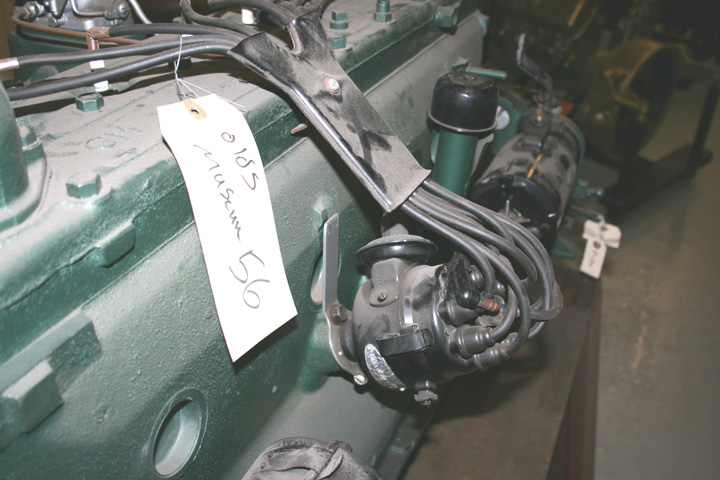
The Delco-Remy distributor appears to be
1110808 with serial number 7L4.


The vacuum advance is plumbed with a copper
line.
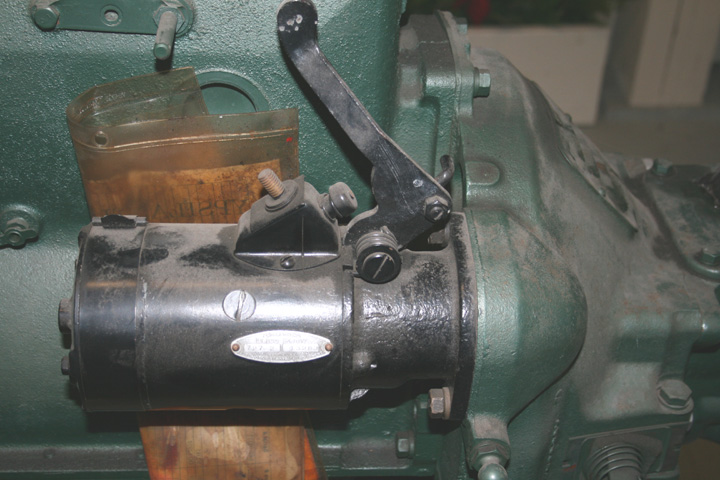
Delco-Remy starter Model 727 Z, Serial Number 13283.
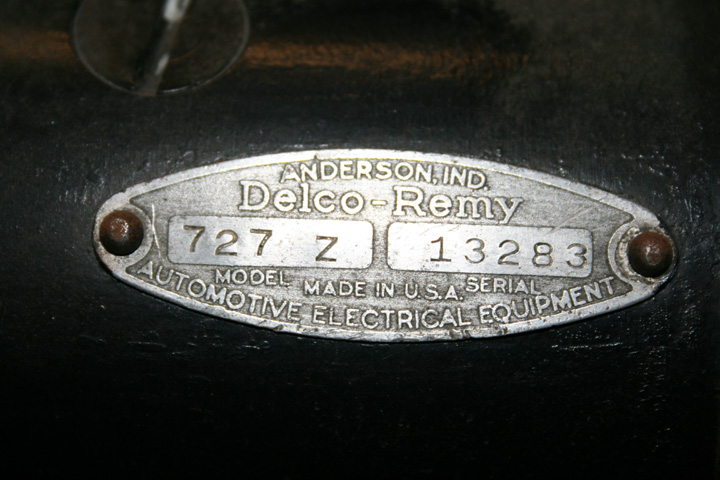

Before there was Delco-Remy there was Fisher
Body for two of us that came to Anderson, IN from Lansing, MI. The
Durant Plant in the photo above was purchased by GM in 1935 for the use of
Fisher Body. During WWII my father worked here until drafted into
the Army and my mother came to work in the plant during the war not as a
Rosie the Riveter but as a production control secretary. Upon his
return to Fisher Body from service after WWII my father met my mother at
the plant and they got married. After high school while going to
college both myself and my sister had summer jobs in the plant. The plant is facing Verlinden Avenue which runs north
and south. The street running east and west is Michigan Ave.
The high school that we went to was built in the early 40s on the south
side of Michigan at Verlinden. My sister and I literally walked
across the street after graduating to start our years with GM.
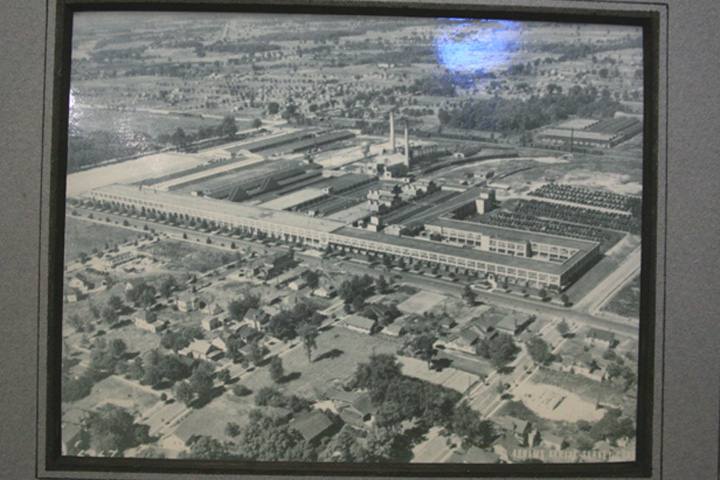
The Fisher Body Plant in later years but not
yet the final product. The horseshoe shaped building on the right or
north end had already been filled in when I was there. On the south end that
would become an addition known as Building 3X. After I came to DR
more additions were made. Note that what was an empty subdivision
with only a couple of houses in the previous photo is now filled in with
houses and mature trees.
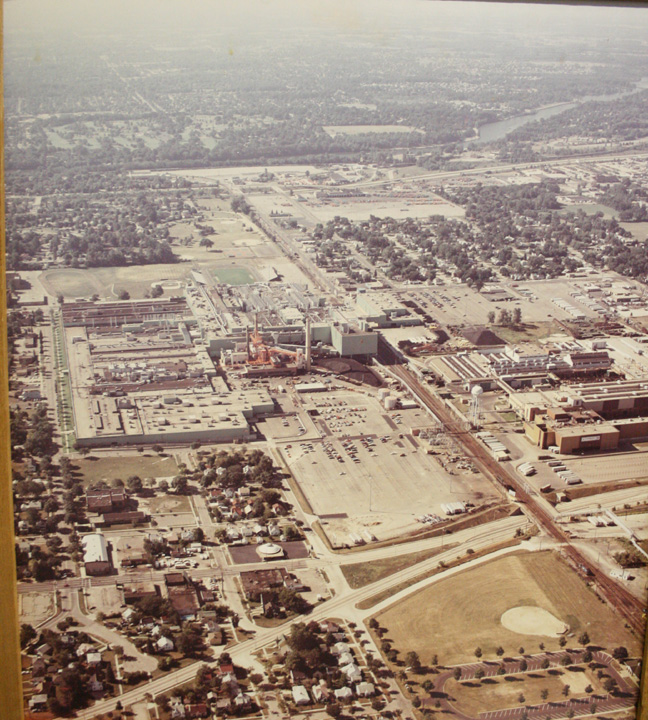
This is the final version of Lansing Fisher
Body before it was razed in 2008. One is looking south with
Verlinden Ave running down the left hand side of the photo. Fisher Body is
the plant to the left or east of the Fisher Body Power House in the center
and the railroad tracks that run north and south on the right or west side
of the photo.. Fisher Body supplied bodies to the Olds main assembly
plant that later became Lansing Auto Assembly as things changed with GM in
Lansing and Olds going away. Fisher Body became Lansing Body
Assembly after Roger Smith decided it did not need to exist as a separate
entity in 1984. The plant to the right of the photo is an Olds plant
and the aircraft that took the photo is over another Olds plant that was
built like DR Plant 11 was to make jet engine parts for the Korean war.
While DR supplied Allison Davison I believe the Olds Jet Plant as it was
called supplied parts to Buick which was making the Sapphire jet engine
under license from Curtiss-Wright Corporation. To get to the main
Olds complex from this location one would go south to the Grand River and
then left or east about a half a mile to the original location of Olds in
Lansing. One of the things I was able to do before the plant closed
was to get both of my children tours of this plant and the Olds before
they closed. Hopefully they understand their roots.
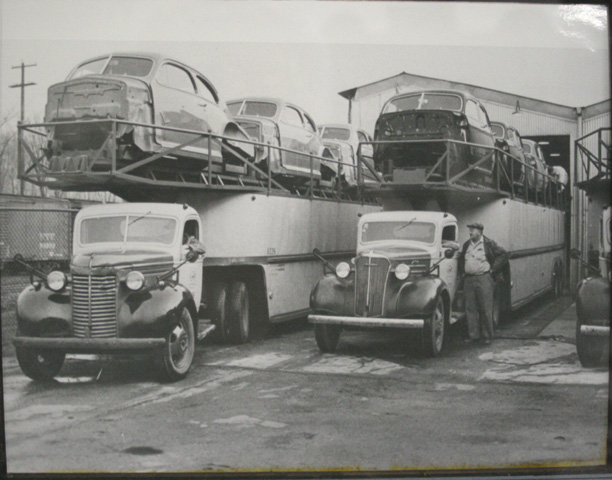
Fisher Body Lansing supplied the auto bodies
which was the passenger compartment from the firewall back to The Olds.
The bodies would be loaded on tractor trailers and trucked about a mile
and half away to the Olds or Lansing Final Assembly as it was called
later. In the photo above one is looking north from Michigan Avenue at the
west end of the complex. Note the railroad cars on the track in the
background which was the west boundary of the property. The Lansing
operation was the last GM operation where the body assembly was remote
from the final assembly. In the fifties Lansing Fisher Body made
convertibles bodies for Chevrolet which were then trucked to Flint.
The Toronado bodies were made at the Fisher Body Plant in Flint on the
same line as Buick Riveras and trucked to Lansing for final assembly.

During WWII Lansing Fisher Body contributed to
the war effort by making parts for the Boeing B-29. I remember my
mother telling me that little people were hired to get inside the cramped
confines of the control surfaces being made a the plant (ailerons,
rudders, and elevators) to assist in the
assembly of the structures. Parts out of the Lansing Fisher Body
Plant would have gone to aircraft assembly plants in Renton, WA, Wichita,
KS, Marietta, GA, and Omaha, NB. The B-29 project was actually more
expensive than the Manhattan Project to produce the Atomic Bomb, which was
$2.5 billion in WWII dollars versus the $3 billion for the B-29.
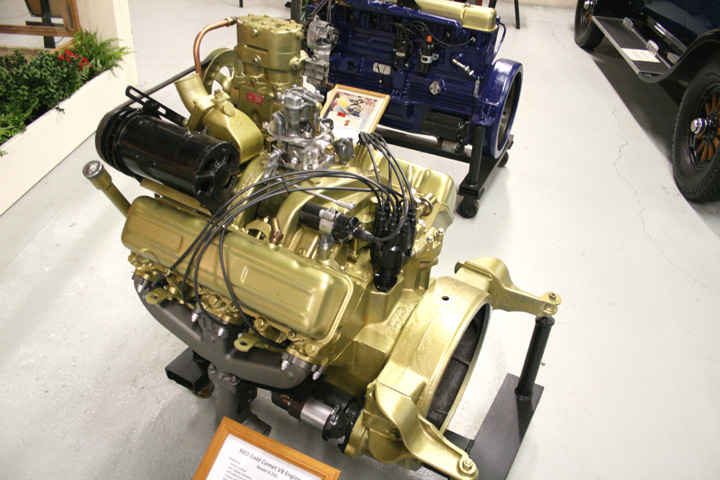
A REO Gold Comet V8 with DR starter,
distributor, coil and generator.
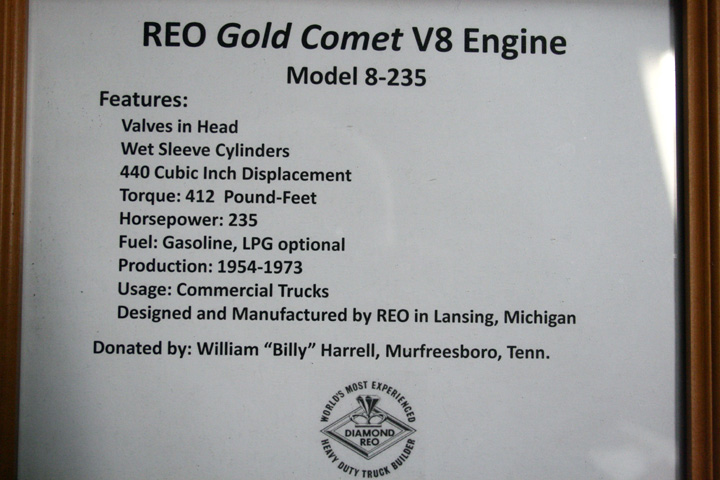

Reo moved from a foot switch to a solenoid on the starter for this engine.
This is a DR starter and solenoid but there is no way to get a photo of
the end of the markings.
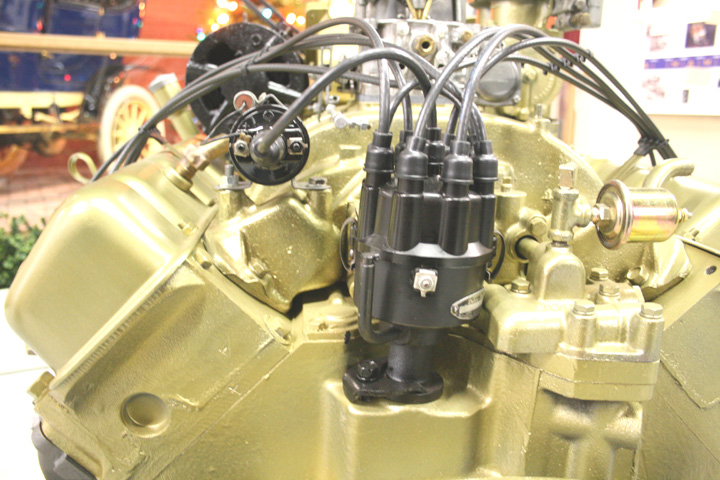
The DR distributor, Model 1110632, Serial Number 2C 8, and coil which has
the capacitor mounted to it.
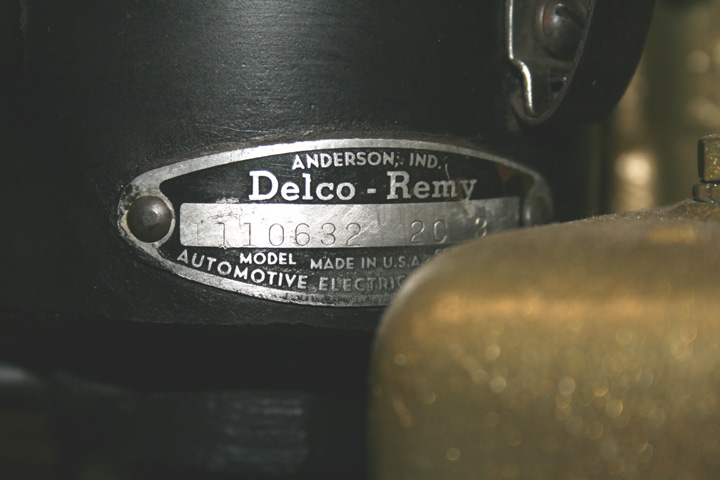
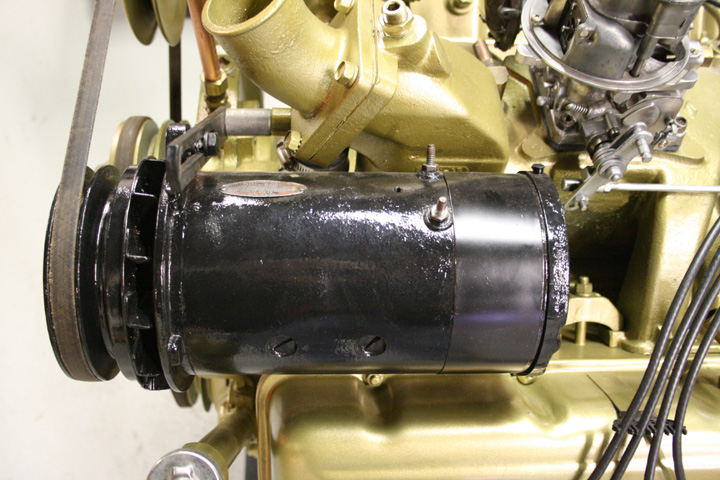
Delco-Remy 12 Volt DC Generator 1106821,
Serial Number 42843.
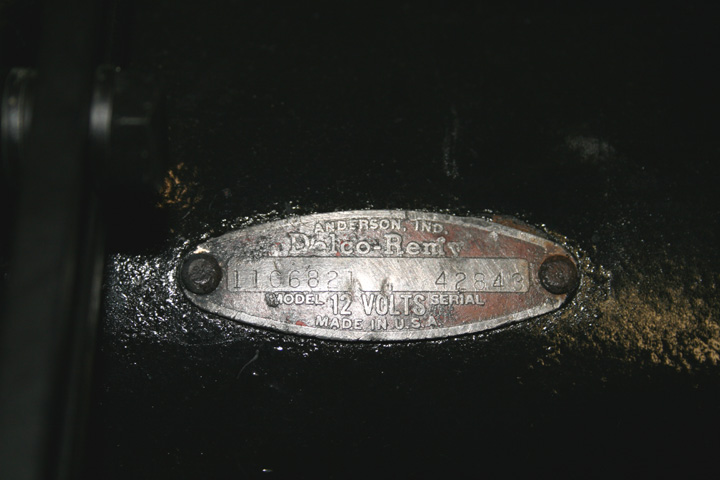

There was also a straight six version of the Gold Comet. This sample
has a Delcotron and Remy distributor. The starter was not
identifiable and the starter solenoid was from another manufacturer.
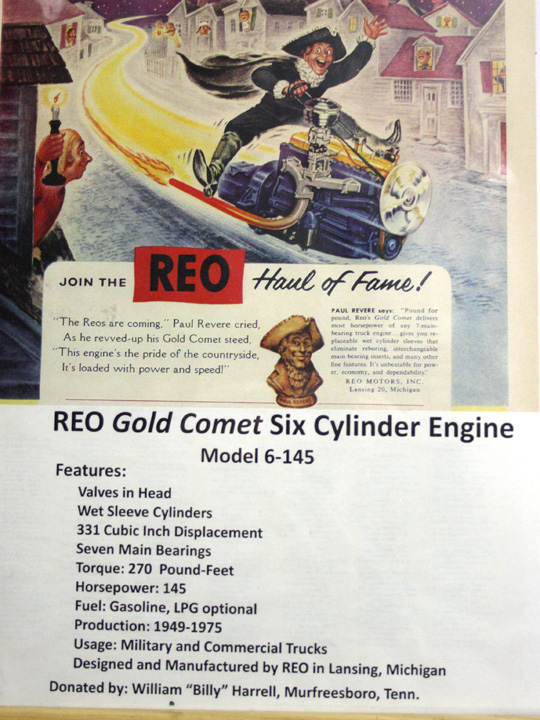
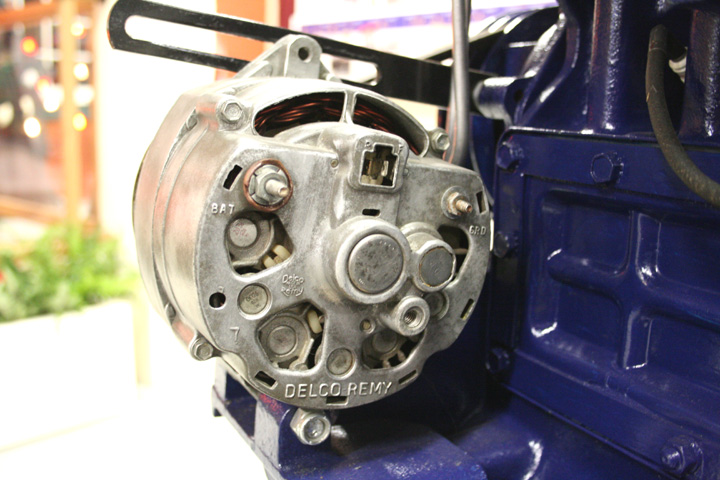
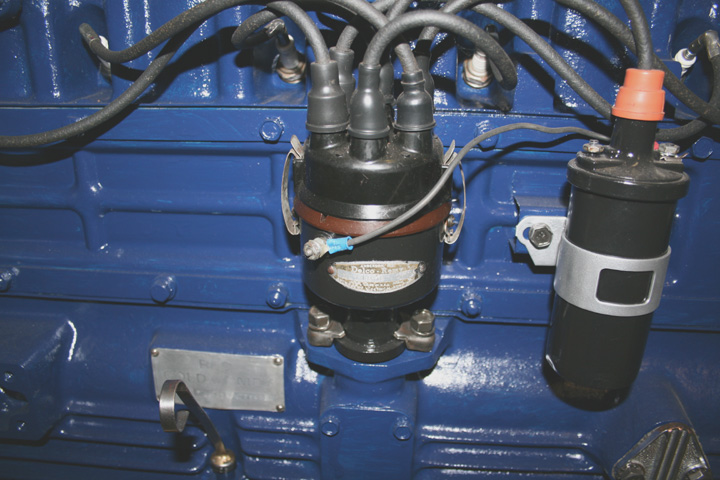
The DR Distributor is model 1111896, Serial
0F16.

On to Olds and the Olds Viking Engines:

Oldsmobile introduced the Viking automobile in
1929. Not a good time for a new product as it also coincided with
the start of the Great Depression and only lasted two years.
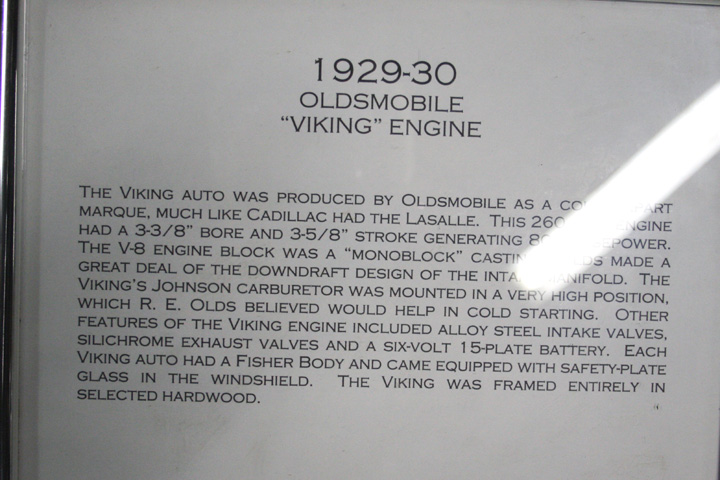
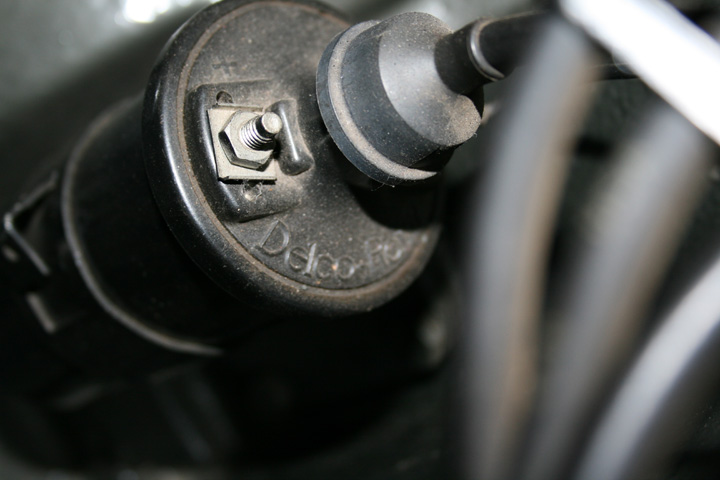
Delco-Remy Coil.

The Remy Distributor is Model 6581, Serial
3195.
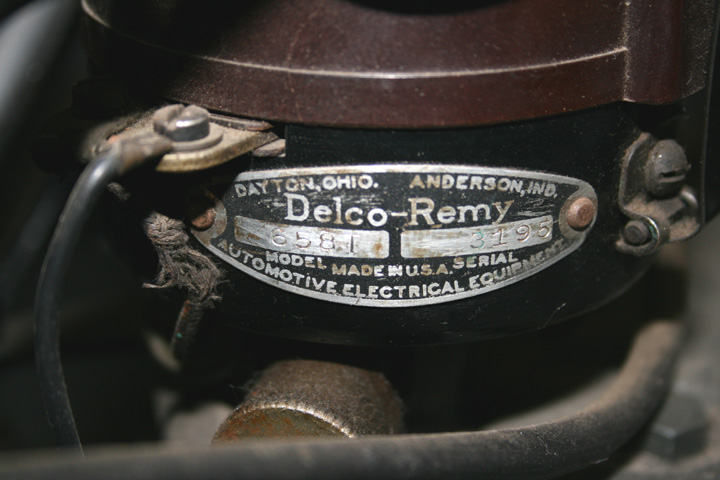
Here is another example of the ID tag showing
both Dayton, OH and Anderson, IN on the tag. In 1928 DR took over
the DELCO electrical product line in Dayton.
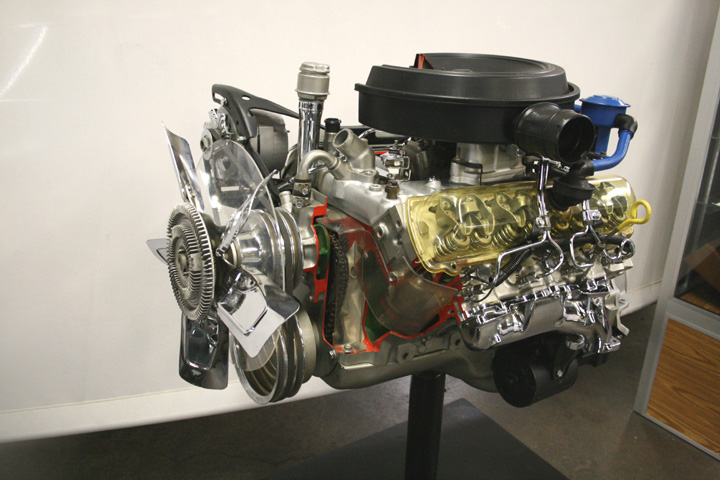
The infamous Olds V-8 Diesel with DR starter
and Delcotron.
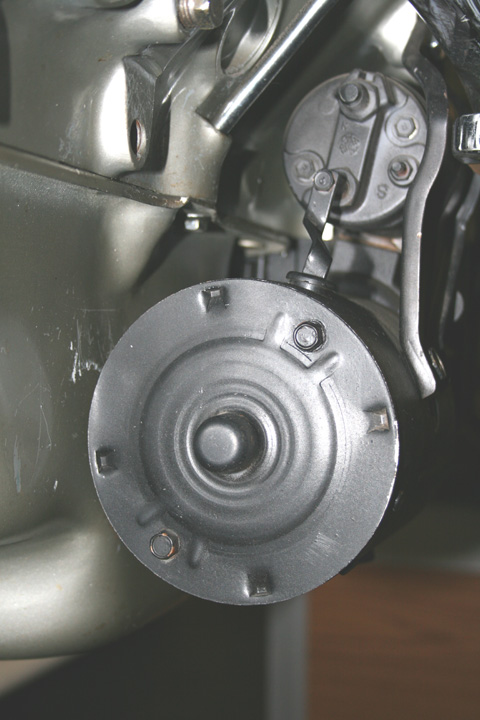
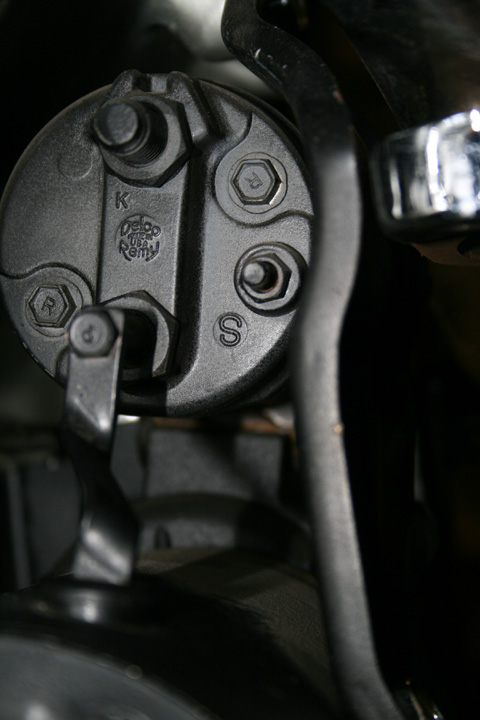
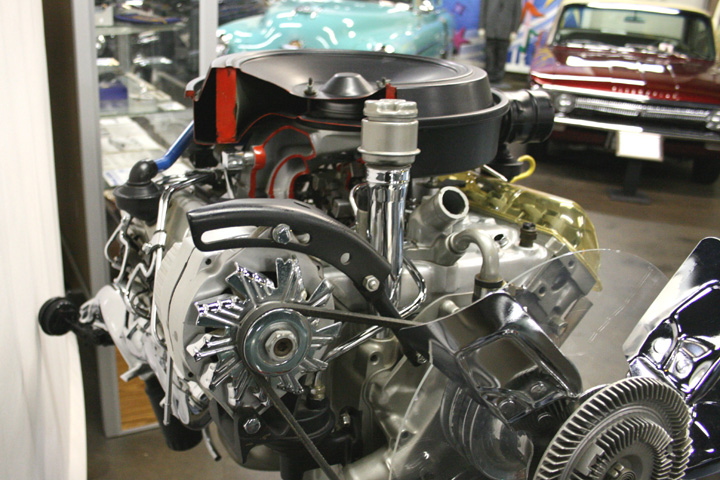

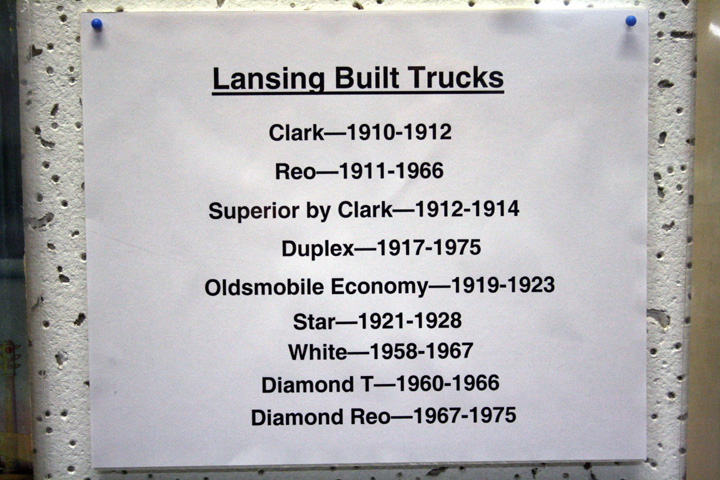
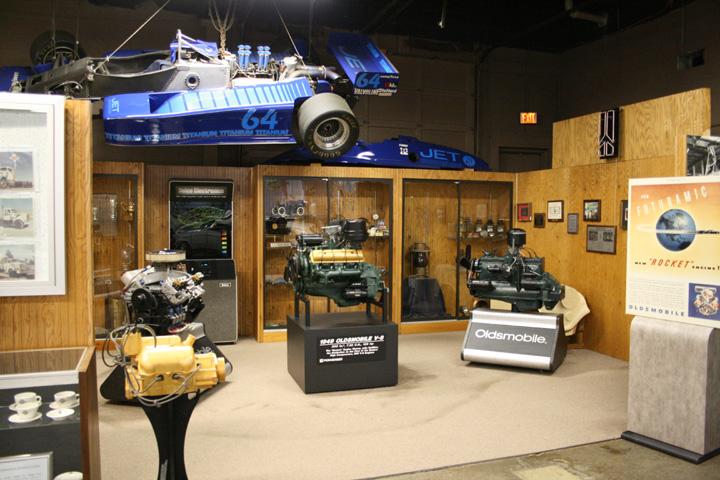
The Olds engine display area. The yellow
engine to the left is actually a wooden model shop display.
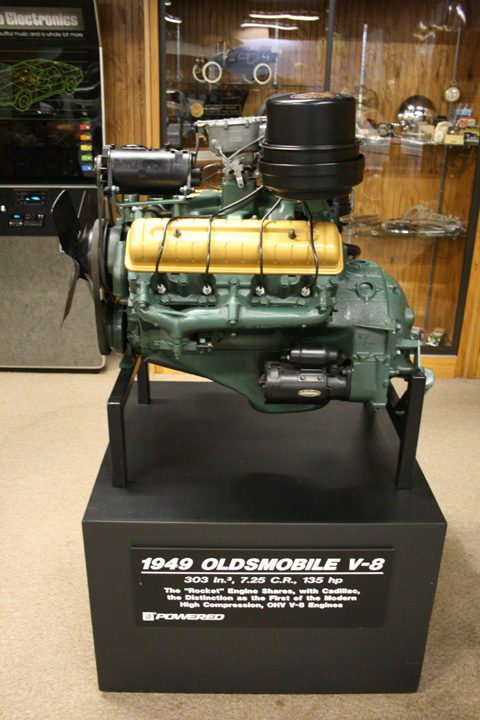
The original Rocket V-8. The world was
just entering the jet and rocket age after WWII so the term "rocket" would
denote the speed of heat. This appears to be the first one built on
July 13, 1948.
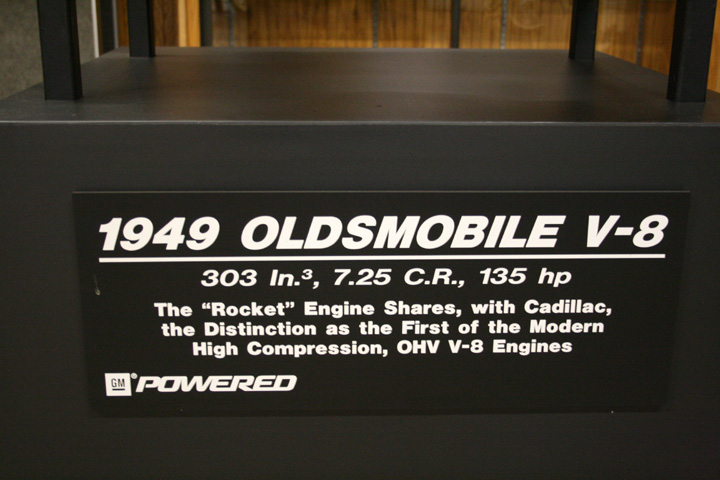
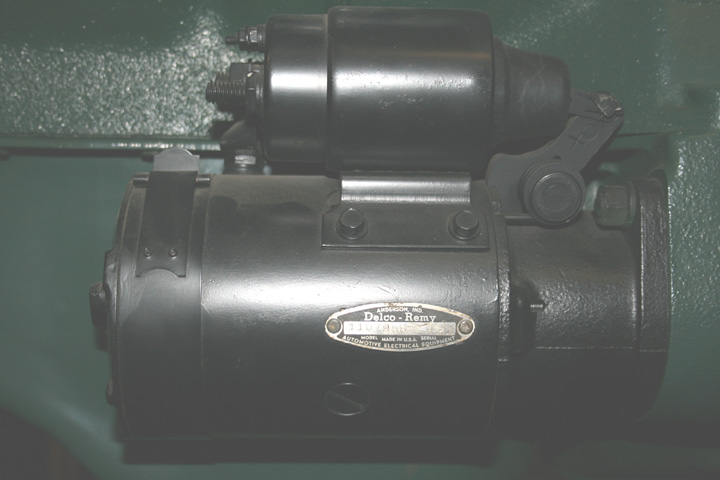
Before you can "blast off' in your Rocket V-18
you need to start it. And of course the best way is with a
Delco-Remy starter.


DR DC generator 1102704 Serial number 0D 4.

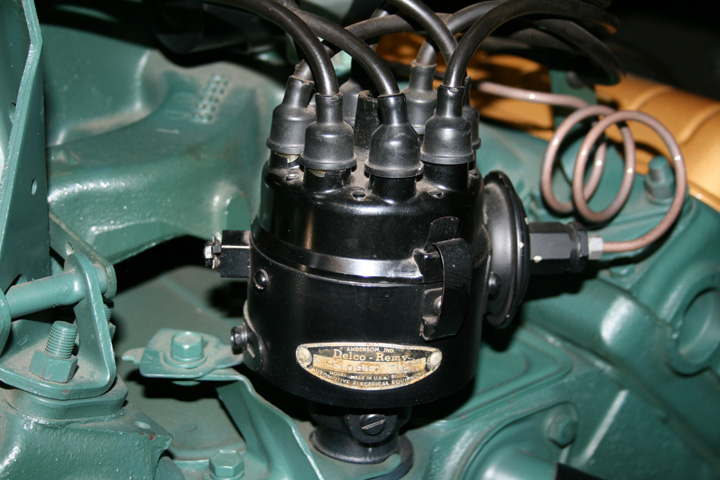
If one is going to ignite that Olds rocket, a
DR distributor is in order.
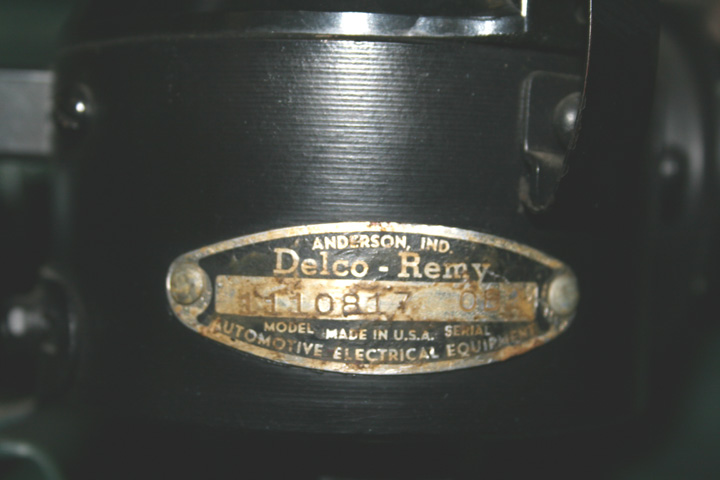
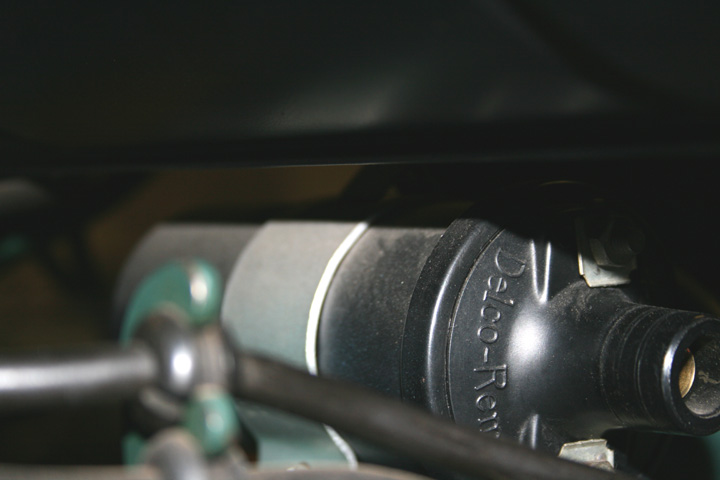
The Rocket V-8 used a Delco-Remy coil.

This Olds Straight Six looked to have DR parts
but only the ignition coil could be identified for sure. Note that
the 40's and 50s's engines are painted green, later to become gold.

This 2.5 liter experimental 1983 Olds Diesel
has a DR Alternator.
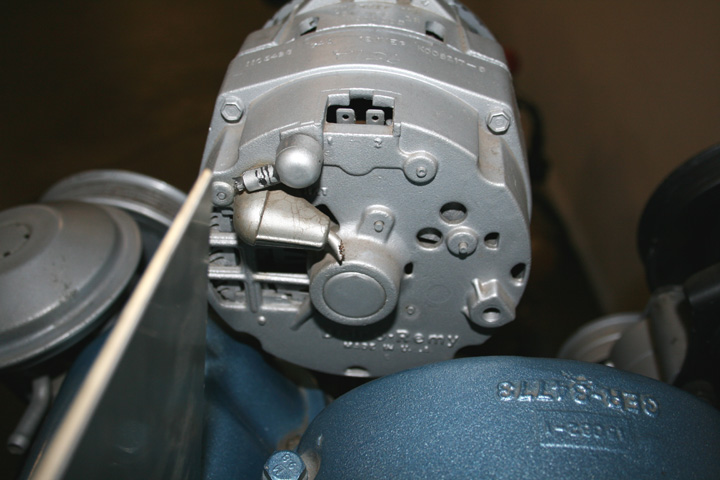
This is a model 1105423.
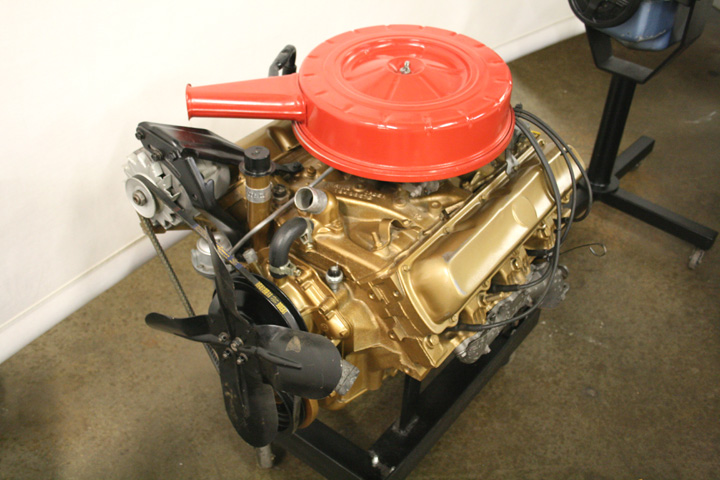
This unidentified pre 1975 Rocket V-8 has a
Delco-Remy Delcotron, Ignition Coil and what appears to be a DR
distributor. The Olds engine is now painted gold rather than green.
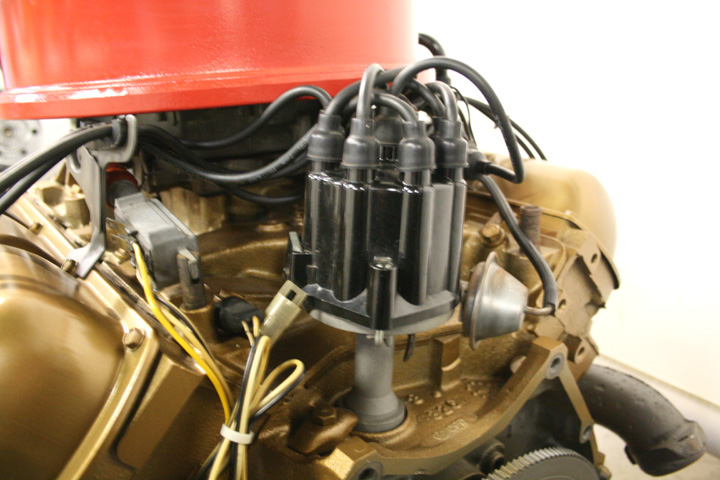
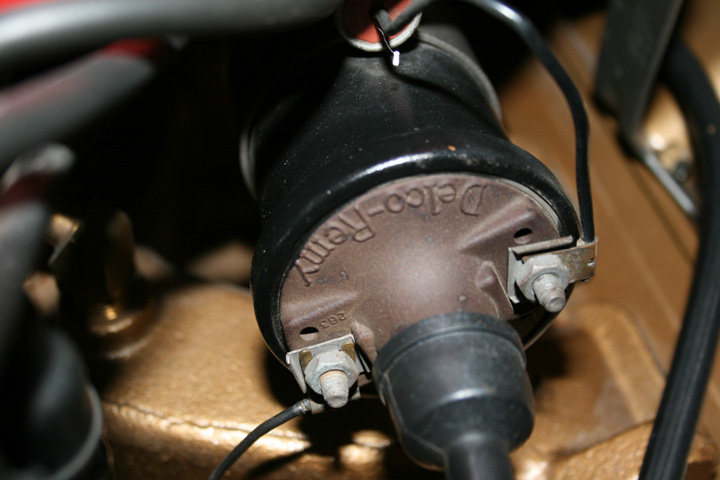

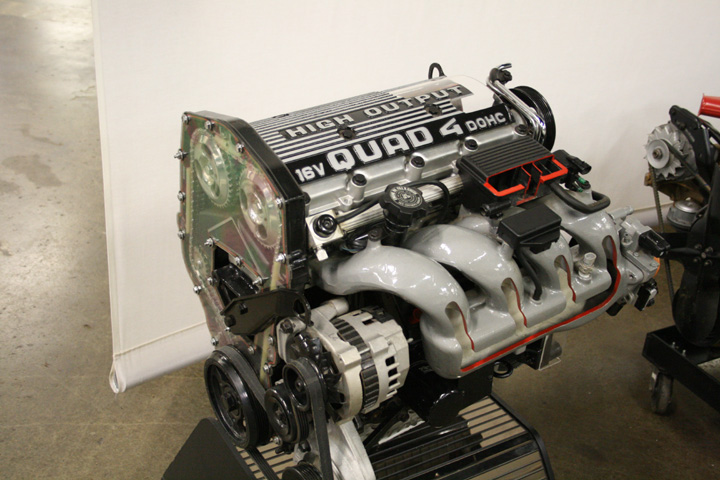
The Olds Quad Four with DR Integrated Direct
Ignition (IDI) system, knock sensor, and CS-130 alternator.
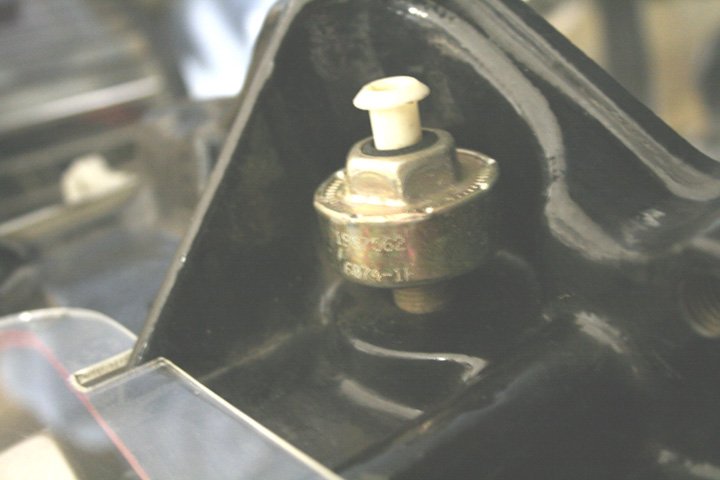
For the first time a DR knock senor, 1997562
shows up on an engine.

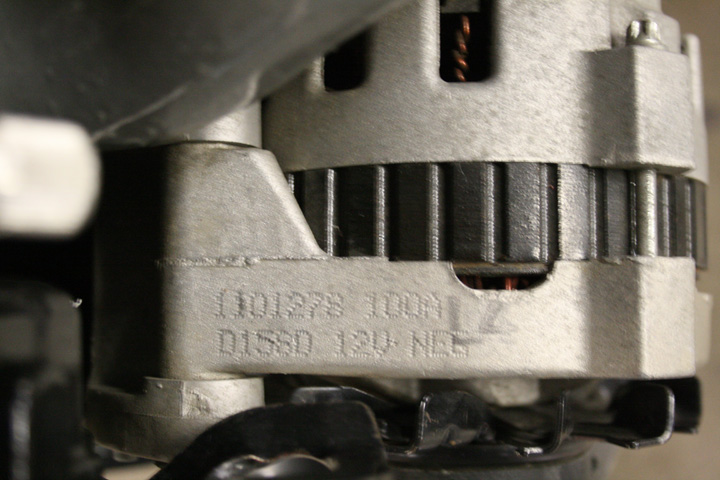
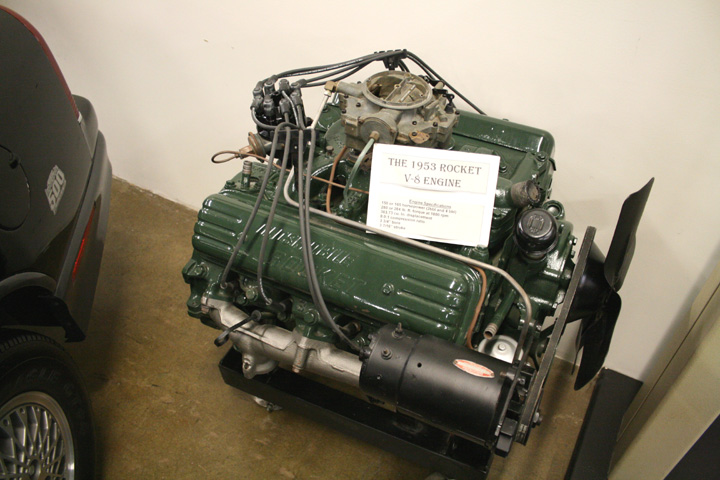
Another Rocket V-8. Note that this is
painted green.
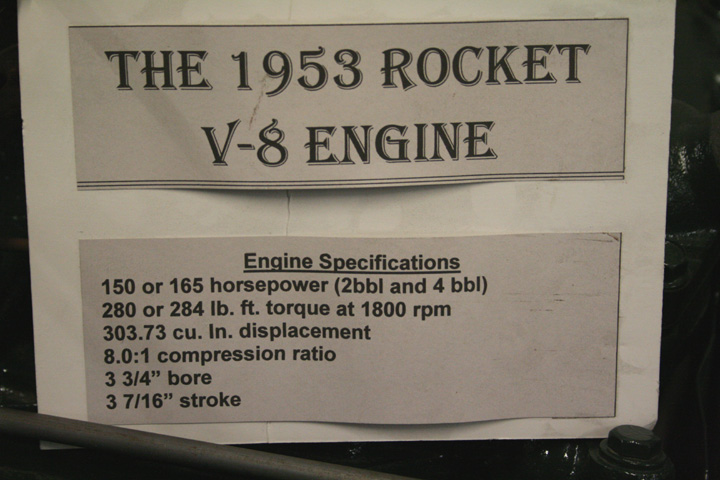
This engine has a Delco-Remy DC Generator, Distributor

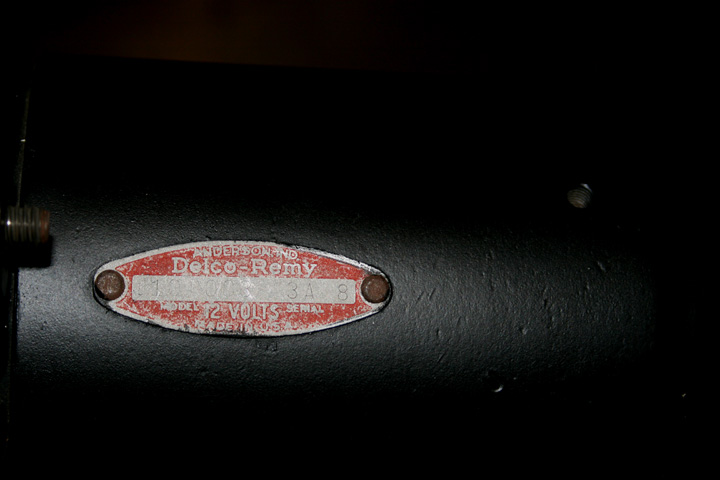
The model number on the generator appears to be 1103008 with a serial
number of 3A 8.

Model 1110824, Serial 3A 8 on the distributor.

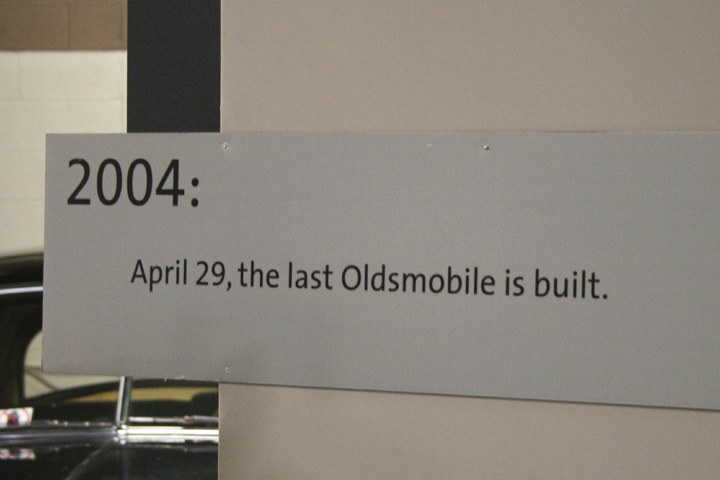
Everything has a beginning and an end.
This end came way too soon and should never have happened.
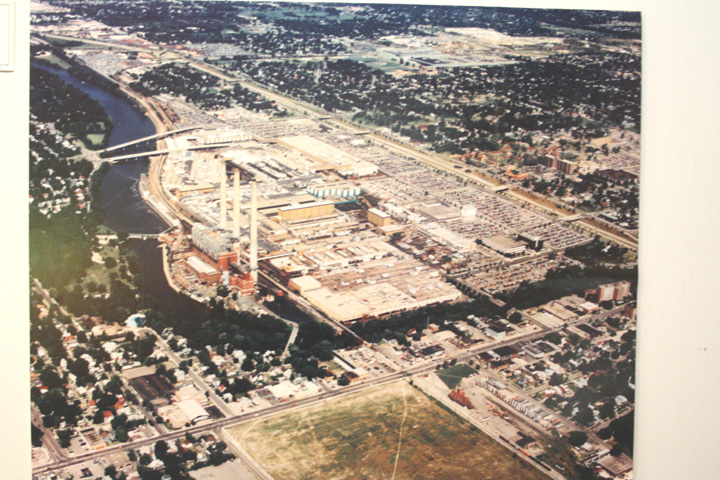
This is the Olds Main complex in Lansing.
The power plant belongs to the city of Lansing and not GM as many persons
have thougth over the years. In the park across the Grand River from
the power plant I used to play ball, fish and swim at the municipal pool.
The green area at the bottom of the photo is where the Reo used to be
until it was torn down in 1979. Much of the Olds complex was also
torn down and replaced with the GM Grand River Plant that now builds the
Cadillac CTS. In the upper right is the Fisher Body - Olds Complex
along Saginaw Street.

Back to the future. The electric car has
been tried many times in the past with a new emphasis coming in the early
21st century. The drive motors, battery pack and batteries were
developed for the EV1 under the Impact program at Delco-Remy. It
will be interesting to see how successful the next generation of pure
electric (not hybrid) vehicles are in the current product introductions.
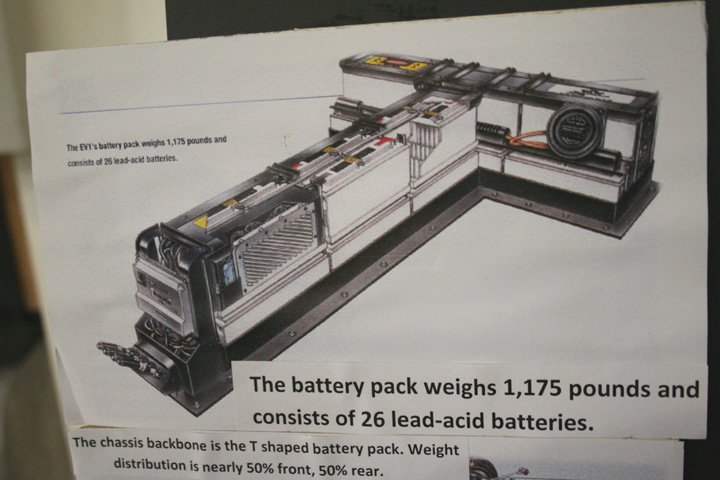
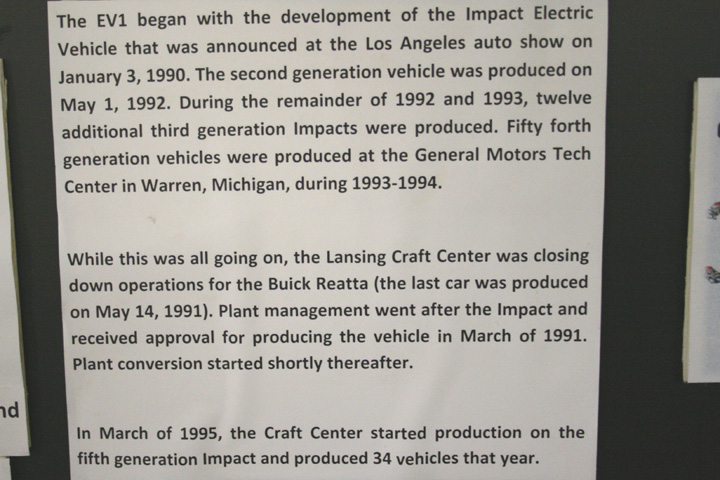
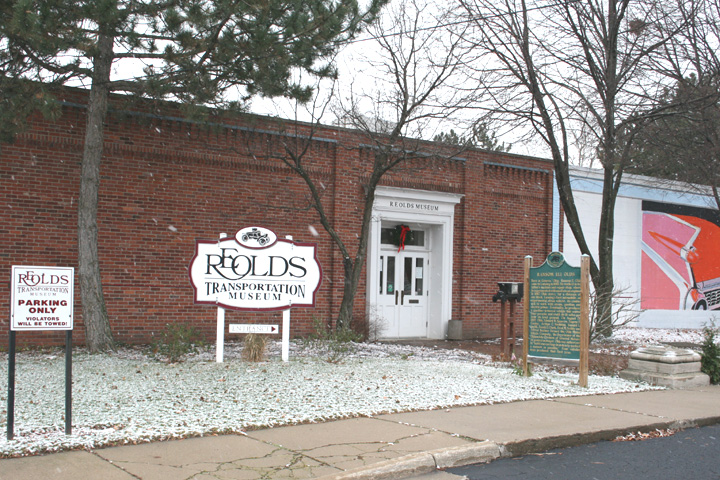
Air
Force Museum America's
Packard Museum Auburn Cord
Duesenberg Museum Buick Museum
Chrysler
Museum John
Deere Tractor and Engine Museum Gilmore Car Museum
Kansas Aviation
Museum Kokomo Auto Museum
Michigan
Firehouse Museum
Missouri Museum of Military
History Museum of
Flight National
Automobile and Truck Museum
National Packard Museum
North Carolina Maritime Museum
Rolls-Royce Heritage Trust
Allison Branch
RE Olds Transportation
Museum Ropkey
Armor Museum Studebaker Museum
USS Alabama Aviation Museum
War in the Pacific Museum
Wright Museum of WWII
Ypsilanti Automotive Heritage Museum
|



































































































